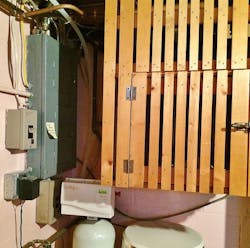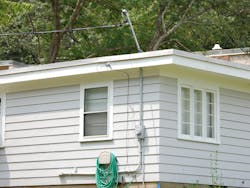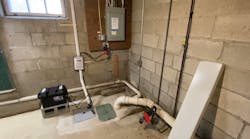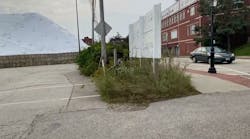All references are based on the 2014 edition of the NEC.
A Laundry List of Problems
Kevin King, one of our readers, sent in this photo with the following quote: “I read your column every month and enjoy seeing the things that you find. I was asked to help a new homeowner install some flooring. During the tour of the rest of the home, she pointed out the water softener installation that she was going to have the softener company correct. I noticed and commented that the required clearance to the front of the electrical panel was not present due to the clothes hamper.”
Kevin, thanks so much for sharing this great photo. You are correct about the lack of required clearances in front of this panelboard. Section 110.26(A) requires the working space in front of this panelboard to be kept clear for a depth of 3 ft, a width of at least 30 in., and a height of 6½ ft.
Another problem I noticed is the water pipe below the panel appears to be in violation of the dedicated space requirements of Sec. 110.26(E)(1)(a), which requires the space directly above and below the panelboard to be dedicated to the electrical installation. No foreign systems are permitted in this space.
Can You Lend Some Support?
It appears that this service mast is about to fold over onto itself. That would be a really bad situation!
Section 230.28(B) requires power service masts to be of adequate strength to withstand the weight and strain imposed by the overhead conductors. If the mast alone cannot provide enough strength and support, then braces or guy wires shall be used to provide additional support. Perhaps this installer should have installed some guy wires for this mast. Now that the mast is bent over, it’s also possible the overhead wires are hanging too low. Sections 230.24(B)(1) through (4) establish the minimum height requirements for these 120/240V overhead service conductors, including: 10 ft minimum above grade for drip loops and pedestrian-only areas; 12 ft over driveways and residential property; and
18 ft over public streets and roads. These wires are not as high as they were when this mast was installed due to the damaged pipe. We can only hope that a large truck doesn’t come down the street and accidently hit these overhead lines and tear them off the building before a repair can be made.






